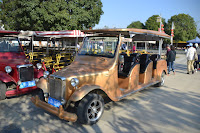Not wishing to be late for the cruise, we went on foot to the jetty reaching it at about 0900. The cruise started at about 1030. We were ushered into the vessel to a large hall on Level 1. Rows of chairs (free seating) occupied this hall. We were free to wander throughout the different levels of the vessel. However, only the seats at Level 1 cost nothing.
In the end, we paid RMB50 for a VIP seat on Level 3 where the view was better. Free Three Gorges coloured stones were given to all guests.
XILING SHIP-LOCK
Vessel approaching the XiLing Ship-Lock.
As we were going upstream, higher walls
were seen ahead.
Gates closing behind the vessel.
Water rushed in below the vessel, pushing it to
a higher elevation. Gates open in front of vessel.
Vessel leaves the ship-lock.
 |  |
 |  |
|
|
|
|
GEZHOUBA DAM
After a hearty lunch by the banks of the Yangtze River, we were on our way to a vantage point to see five ship-locks at a hydroelectric power generation dam. Each ship-lock took the vessel to a higher elevation. As there were 5 ship-locks here, the difference in water level was tremendous.
|
|
 |  |
 |
|
A slight drizzle dampened our spirit and kept us dampened for the next three hours. We left the dam at 1800. It was another 2½ hour's drive to XingShan.
It was total darkness by the time we crossed the Guzhao Highway. (picture right) It was described as the "most beautiful highway on water". To avoid destroying a forest, the Chinese built this highway to ZhaoJunQiao in XingShan County.
|
|
XingShan was cold, misty and quiet. The road towards ZhaoJun Hotel was littered with construction material. Ms Helena explained that the authorities were using the *Wang Zhaojun theme to develop XingShan .
*Wang Zhaojun was one of the four great beauties in Chinese history. She was born in a small village (now called Zhaojun Village) in Xingshan during the Western Han Dynasty. Called to the Imperial Harem, she refused to bribe the palace artist, who painted some moles onto her face. On account of this ugly image, she was rejected by the emperor. After a subsequent conflict with the XiongNu, the ugliest lady in the Imperial Harem was given a title (princess) and sent off on a marriage alliance with the XiongNu ruler. Before departing for the distant land, Wang Zhaojun met the Han emperor for the first and last time. The emperor exploded into a rage when he saw how beautiful she was and the palace artist responsible for her previous portrait was executed.My fitness tracker read 9231 steps.



























